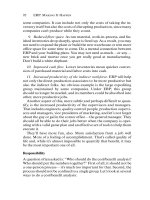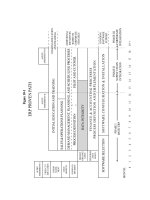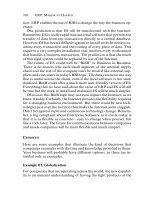IT training the HAProxy guide to multi layer security khotailieu
Bạn đang xem bản rút gọn của tài liệu. Xem và tải ngay bản đầy đủ của tài liệu tại đây (1.86 MB, 133 trang )
The HAProxy Guide to
Multi-Layer Security
Defense in Depth Using
the Building Blocks of
HAProxy
Chad Lavoie
© 2019 HAProxy Technologies
Table of Contents
Our Approach to Multi-Layer Security
4
Introduction to HAProxy ACLs
6
Formatting an ACL
7
Fetches
11
Converters
12
Flags
13
Matching Methods
14
Things to do with ACLs
16
Selecting a Backend
18
Setting an HTTP Header
20
Changing the URL
21
Updating Map Files
21
Caching
23
Using ACLs to Block Requests
23
Updating ACL Lists
26
Conclusion
27
Introduction to HAProxy Stick Tables
28
Uses of Stick Tables
29
Defining a Stick Table
31
Making Decisions Based on Stick Tables
44
Other Considerations
49
Conclusion
54
Introduction to HAProxy Maps
55
The Map File
56
Modifying the Values
60
The HAProxy Guide to Multi-Layer Security
2
Putting It Into Practice
68
Conclusion
72
Application-Layer DDoS Attack Protection
73
HTTP Flood
74
Manning the Turrets
75
Setting Request Rate Limits
77
Slowloris Attacks
81
Blocking Requests by Static Characteristics
82
Protecting TCP (non-HTTP) Services
86
The Stick Table Aggregator
89
The reCAPTCHA and Antibot Modules
90
Conclusion
93
Bot Protection with HAProxy
HAProxy Load Balancer
Bot Protection Strategy
94
95
96
Beyond Scrapers
105
Whitelisting Good Bots
109
Identifying Bots By Their Location
111
Conclusion
114
The HAProxy Enterprise WAF
115
A Specific Countermeasure
116
Routine Scanning
117
HAProxy Enterprise WAF
124
Retesting with WAF Protection
126
Conclusion
129
The HAProxy Guide to Multi-Layer Security
3
Our Approach to
Multi-Layer Security
D
efending your infrastructure can involve a dizzying
number of components: from network firewalls to
intrusion-detection systems to access control safeguards.
Wouldn't it be nice to simplify this? We always like to be the
bearer of good news. So, do you know that the HAProxy load
balancer—which you might already be using—is packed full
of security features?
HAProxy is used all over the globe for adding resilience to
critical websites and services. As a high-performance,
open-source load balancer that so many companies depend
on, making it reliable gets top billing and it's no surprise that
that's what people know it for. However, the same
components that you might use for sticking a client to a
server, routing users to the proper backend, and mapping
large sets of data to variables can be used to secure your
infrastructure.
In this book, we decided to cast some of these battle-tested
capabilities in a different light. To start off, we'll introduce you
The HAProxy Guide to Multi-Layer Security
4
to the building blocks that make up HAProxy: ACLs, stick
tables, and maps. Then, you will see how when combined
they allow you to resist malicious bot traffic, dull the power of
a DDoS attack, and other handy security recipes.
HAProxy Technologies, the company behind HAProxy, owns
its mission to provide advanced protection for those who
need it. Throughout this book, we'll highlight areas where
HAProxy Enterprise, which combines the stable codebase of
HAProxy with an advanced suite of add-ons, expert support
and professional services, can layer on additional defenses.
At the end, you'll learn about the HAProxy Web Application
Firewall, which catches application-layer attacks that are
missed by other types of firewalls. In today's threat-rich
environment, a WAF is an essential service.
This book is for those new to HAProxy, as well as those
looking to learn some new tricks. In the end, if we've
heightened your awareness to the attacks leveraged by
hackers and the creative ways of shutting them down, then
we'll feel like we've done our job.
The HAProxy Guide to Multi-Layer Security
5
Introduction to
HAProxy ACLs
W
hen IT pros add load balancers into their
infrastructure, they’re looking for the ability to scale out their
websites and services, get better availability, and gain more
restful nights knowing that their critical services are no longer
single points of failure. Before long, however, they realize that
with a full-featured load balancer like HAProxy Enterprise,
they can add in extra intelligence to inspect incoming traffic
and make decisions on the fly.
For example, you can restrict who can access various
endpoints, redirect non-HTTPS traffic to HTTPS, and detect
and block malicious bots and scanners; you can define
conditions for adding HTTP headers, change the URL or
redirect the user.
Access Control Lists, or ACLs, in HAProxy allow you to test
various conditions and perform a given action based on those
tests. These conditions cover just about any aspect of a
request or response such as searching for strings or patterns,
checking IP addresses, analyzing recent request rates (via
The HAProxy Guide to Multi-Layer Security
6
stick tables), and observing TLS statuses. The action you take
can include making routing decisions, redirecting requests,
returning static responses and so much more. While using
logic operators (AND, OR, NOT) in other proxy solutions might
be cumbersome, HAProxy embraces them to form more
complex conditions.
Formatting an ACL
There are two ways of specifying an ACL—a named ACL and
an anonymous or in-line ACL. The first form is a named ACL:
acl is_static path -i -m beg /static
We begin with the acl keyword, followed by a name, followed
by the condition. Here we have an ACL named is_static. This
ACL name can then be used with i
f and unless statements
such as use_backend be_static if is_static. This form
is recommended when you are going to use a given condition
for multiple actions.
acl is_static path -i -m beg /static
use_backend be_static if is_static
The condition, p
ath -i -m beg /static, checks to see if
the URL starts with /static. You’ll see how that works along
with other types of conditions later in this chapter.
The second form is an anonymous or in-line ACL:
The HAProxy Guide to Multi-Layer Security
7
use_backend be_static if { path -i -m beg /static
}
This does the same thing that the above two lines would do,
just in one line. For in-line ACLs, the condition is contained
inside curly braces.
In both cases, you can chain multiple conditions together.
ACLs listed one after another without anything in between
will be considered to be joined with an and. The condition
overall is only true if both ACLs are true. ( Note: ↪ means
continue on same line)
http-request deny if { path -i -m beg /api }
↪ { src 10.0.0.0/16 }
This will prevent any client in the 1
0.0.0.0/16 subnet from
accessing anything starting with /api, while still being able to
access other paths.
Adding an exclamation mark inverts a condition:
http-request deny if { path -i -m beg /api }
↪ !{ src 10.0.0.0/16 }
Now only clients in the 1
0.0.0.0/16 subnet are allowed to
access paths starting with /api while all others will be
forbidden.
The IP addresses could also be imported from a file:
The HAProxy Guide to Multi-Layer Security
8
http-request deny if { path -i -m beg /api }
↪ { src -f /etc/hapee-1.9/blacklist.acl }
Within blacklist.acl you would then list individual or a range
of IP addresses using CIDR notation to block, as follows:
192.168.122.3
192.168.122.0/24
You can also define an ACL where either condition can be
true by using ||:
http-request deny if { path -i -m beg /evil } ||
↪ { path -i -m end /evil }
With this, each request whose path starts with / evil (e.g.
/evil/foo) or ends with /evil (e.g. /foo/evil) will be denied.
You can also do the same to combine named ACLs:
acl starts_evil path -i -m beg /evil
acl ends_evil path -i -m end /evil
http-request deny if starts_evil || ends_evil
With named ACLs, specifying the same ACL name multiple
times will cause a logical OR of the conditions, so the last
block can also be expressed as:
The HAProxy Guide to Multi-Layer Security
9
acl evil path_beg /evil
acl evil path_end /evil
http-request deny if evil
This allows you to combine ANDs and ORs (as well as named
and in-line ACLs) to build more complicated conditions, for
example:
http-request deny if evil !{ src 10.0.0.0/16 }
This will block the request if the path starts or ends with / evil,
but only for clients that are not in the 10.0.0.0/16 subnet.
Did you know? Innovations such as Elastic Binary Trees or
EB trees have shaped ACLs into the high performing feature
they are today. For example, string and IP address matches
rely on EB trees that allow ACLs to process millions of entries
while maintaining the best in class performance and
efficiency that HAProxy is known for.
From what we’ve seen so far, each ACL condition is broken
into two parts—the source of the information (or a fetch),
such as path and s
rc, and the string it is matching against. In
the middle of these two parts, one can specify flags (such as
-i for a case-insensitive match) and a matching method (beg
to match on the beginning of a string, for example). All of
these components of an ACL will be expanded on in the
following sections.
The HAProxy Guide to Multi-Layer Security
10
Fetches
Now that you understand the basic way to format an ACL
you might want to learn what sources of information you can
use to make decisions on. A source of information in HAProxy
is known as a fetch. These allow ACLs to get a piece of
information to work with.
You can see the full list of fetches available in the
documentation. The documentation is quite extensive and
that is one of the benefits of having HAProxy Enterprise
Support. It saves you time from needing to read through
hundreds of pages of documentation.
Here are some of the more commonly used fetches:
src
Returns the client IP address that made
the request
path
Returns the path the client requested
The HAProxy Guide to Multi-Layer Security
11
url_param(foo)
Returns the value of a given URL parameter
req.hdr(foo)
Returns the value of a given HTTP request
header (e.g. User-Agent or Host)
ssl_fc
A boolean that returns true if the connection
was made over SSL and HAProxy is locally
deciphering it
Converters
Once you have a piece of information via a fetch, you might
want to transform it. Converters are separated by commas
from fetches, or other converters if you have more than one,
and can be chained together multiple times.
Some converters (such as lower and upper) are specified by
themselves while others have arguments passed to them. If
an argument is required it is specified in parentheses. For
example, to get the value of the path with / static removed
from the start of it, you can use the regsub converter with a
regex and replacement as arguments:
The HAProxy Guide to Multi-Layer Security
12
path,regsub(^/static,/)
As with fetches, there are a wide variety of converters, but
below are some of the more popular ones:
lower
Changes the case of a sample to lowercase
upper
Changes the case of a sample to uppercase
base64
Base64 encodes the specified string (good for
matching binary samples)
field
Allows you to extract a field similar to awk. For
example if you have “a|b|c” as a sample and run
field(|,3) on it you will be left with “c”
bytes
Extracts some bytes from an input binary sample
given an offset and length as arguments
map
Looks up the sample in the specified map file and
outputs the resulting value
Flags
You can put multiple flags in a single ACL, for example:
path -i -m beg -f /etc/hapee/paths_secret.acl
This will perform a case insensitive match based on the
beginning of the path and matching against patterns stored
The HAProxy Guide to Multi-Layer Security
13
in the specified file. There aren’t as many flags as there are
fetch/converter types, but there is a nice variety.
Here are some of the commonly used ones:
-i
Perform a case-insensitive match (so a sample of
FoO will match a pattern of Foo)
-f
Instead of matching on a string, match from an ACL
file. This ACL file can have lists of IP’s, strings, regexes,
etc. As long as the list doesn’t contain regexes, then
the file will be loaded into the b-tree format and can
handle lookups of millions of items almost instantly
-m
Specify the match type. This is described in detail
in the next section.
You’ll find a handful of others if you scroll down from the ACL
Basics section of the documentation.
Matching Methods
The HAProxy Guide to Multi-Layer Security
14
Now you have a sample from converters and fetches, such as
the requested URL path via path, and something to match
against via the hardcoded path /evil. To compare the former
to the latter you can use one of several matching methods. As
before, there are a lot of matching methods and you can see
the full list by scrolling down (further than the flags) in the
ACL Basics section of the documentation. Here are some
commonly used matching methods:
str
Perform an exact string match
beg
Check the beginning of the string with the pattern,
so a sample of “foobar” will match a pattern of “foo”
but not “bar”.
end
Check the end of a string with the pattern, so a
sample of foobar will match a pattern of bar but
not foo.
sub
A substring match, so a sample of foobar will match
patterns foo, bar, oba.
reg
The pattern is compared as a regular expression
against the sample. Warning: This is CPU hungry
compared to the other matching methods and should
be avoided unless there is no other choice.
found
This is a match that doesn’t take a pattern at all. The
match is true if the sample is found, false otherwise.
This can be used to (as a few common examples) see
if a header (req.hdr(x-foo) -m found) is present, if
a cookie is set (cook(foo) -m found), or if a sample
is present in a map
(src,map(/etc/hapee-1.9/ip_to_country.map)
-m found).
The HAProxy Guide to Multi-Layer Security
15
len
Return the length of the sample (so a sample of foo
with -m len 3 will match)
Up until this point, you may have noticed the use of path -m
beg /evil for comparing our expected path / evil with the
beginning of the sample we’re checking. It uses the matching
method b
eg. There are a number of places where you can use
a shorthand that combines a sample fetch and a matching
method in one argument. In this example p
ath_beg /foo and
path -m beg /foo are exactly the same, but the former is
easier to type and read. Not all fetches have variants with
built-in matching methods (in fact, most don’t), and there’s a
restriction that if you chain a fetch with a converter you have
to specify it using a flag (unless the last converter on the
chain has a match variant, which most don’t).
If there isn’t a fetch variant of the desired matching method,
or if you are using converters, you can use the m flag noted
in the previous section to specify the matching method.
Things to do with ACLs
Now that you know how to define ACLs, let’s get a quick idea
for the common actions in HAProxy that can be controlled by
ACLs. This isn’t meant to give you a complete list of all the
conditions or ways that these rules can be used, but rather
provide fuel to your imagination for when you encounter
something with which ACLs can help.
The HAProxy Guide to Multi-Layer Security
16
Redirecting a Request
The command h
ttp-request redirect location sets the
entire URI. For example, to redirect non-www domains to
their www variant you can use:
http-request redirect location
↪ http://www.%[hdr(host)]%[capture.req.uri]
↪ unless { hdr_beg(host) -i www }
In this case, our ACL, hdr_beg(host) -i www, ensures that
the client is redirected unless their Host HTTP header already
begins with www.
The command h
ttp-request redirect scheme changes
the scheme of the request while leaving the rest alone. This
allows for trivial HTTP-to-HTTPS redirect lines:
http-request redirect scheme https if !{ ssl_fc }
Here, our ACL !{ ssl_fc } checks whether the request did
not come in over HTTPS.
The command h
ttp-request redirect prefix allows you
to specify a prefix to redirect the request to. For example, the
following line causes all requests that don’t have a URL path
beginning with /foo to be redirected to /foo/{original URI
here}:
The HAProxy Guide to Multi-Layer Security
17
http-request redirect prefix /foo if
↪ !{ path_beg /foo }
For each of these a code argument can be added to specify a
response code. If not specified it defaults to 302. Supported
response codes are 301, 302, 303, 307, and 308. For
example:
redirect scheme code 301 https if !{ ssl_fc }
This will redirect HTTP requests to HTTPS and tell clients
that they shouldn’t keep trying HTTP. Or for a more secure
version of this, you could inject the Strict-Transport-Security
header via h
ttp-response set-header.
Selecting a Backend
In HTTP Mode
The use_backend line allows you to specify conditions for
using another backend. For example, to send traffic
requesting the HAProxy Stats webpage to a dedicated
backend, you can combine use_backend with an ACL that
checks whether the URL path begins with / stats:
use_backend be_stats if { path_beg /stats }
The HAProxy Guide to Multi-Layer Security
18
Even more interesting, the backend name can be dynamic
with log-format style rules (i.e. %[<fetch_method>]). In the
following example, we put the path through a map and use
that to generate the backend name:
use_backend
↪ be_%[path,map_beg(/etc/hapee-1.9/paths.map)]
If the file paths.map contains /api api as a key-value pair,
then traffic will be sent to be_api, combining the prefix b
e_
with the string a
pi. If none of the map entries match and
you’ve specified the optional second parameter to the map
function, which is the default argument, then that default will
be used.
use_backend
↪ be_%[path,map_beg(/etc/hapee-1.9/paths.map,
↪ mydefault)]
In this case, if there isn’t a match in the map file, then the
backend be_mydefault will be used. Otherwise, without a
default, traffic will automatically fall-through this rule in
search of another use_backend rule that matches or the
default_backend line.
In TCP Mode
We can also make routing decisions for TCP mode traffic, for
example directing traffic to a special backend if the traffic is
SSL:
The HAProxy Guide to Multi-Layer Security
19
tcp-request inspect-delay 10s
use_backend be_ssl if { req.ssl_hello_type gt 0 }
Note that for TCP-level routing decisions, when requiring
data from the client such as needing to inspect the request,
the inspect-delay statement is required to avoid HAProxy
passing the phase by without any data from the client yet. It
won’t wait the full 10 seconds unless the client stays silent
for 10 seconds. It will move ahead as soon as it can decide
whether the buffer has an SSL hello message.
Setting an HTTP
Header
There are a variety of options for adding an HTTP header to
the request (transparently to the client). Combining these
with an ACL lets you only set the header if a given condition
is true.
add-header
Adds a new header. If a header of the
same name was sent by the client this will
ignore it, adding a second header of the
same name.
set-header
Will add a new header in the same way as
add-header, but if the request already has
a header of the same name it will be
overwritten. Good for security-sensitive flags
that a client might want to tamper with.
The HAProxy Guide to Multi-Layer Security
20
replace-header
Applies a regex replacement of the
named header (injecting a fake cookie
into a cookie header, for example)
del-header
Deletes any header by the specified
name from the request. Useful for
removing an x-forwarded-for header
before option forwardfor
adds a new one (or any custom header
name used there).
Changing the URL
This allows HAProxy to modify the path that the client
requested, but transparently to the client. Its value accepts
log-format style rules (i.e. %
[<fetch_method>]) so you can
make the requested path dynamic. For example, if you
wanted to add /foo/ to all requests (as in the redirect example
above) without notifying the client of this, use:
http-request set-path /foo%[path] if
↪ !{ path_beg /foo }
There is also s
et-query, which changes the query string
instead of the path, and s
et-uri, which sets the path and
query string together.
Updating Map Files
These actions aren’t used very frequently, but open up
interesting possibilities in dynamically adjusting HAProxy
The HAProxy Guide to Multi-Layer Security
21
maps. This can be used for tasks such as having a login
server tell HAProxy to send a clients’ (in this case by session
cookie) requests to another backend from then on:
http-request set-var(txn.session_id)
↪ cook(sessionid)
use_backend
↪ be_%[var(txn.session_id),
↪ map(/etc/hapee-1.9/sessionid.map)]
↪ if { var(txn.session_id),
↪ map(/etc/hapee-1.9/sessionid.map) -m found }
http-response
↪ set-map(/etc/hapee-1.9/sessionid.map)
↪ %[var(txn.session_id)]
↪ %[res.hdr(x-new-backend)]
↪ if { res.hdr(x-new-backend) -m found }
default_backend be_login
Now if a backend sets the x
-new-backend header in a
response, HAProxy will send subsequent requests with the
client’s sessionid cookie to the specified backend. Variables
are used as, otherwise, the request cookies are inaccessible
by HAProxy during the response phase—a solution you may
want to keep in mind for other similar problems that HAProxy
will warn about during startup.
There is also the related del-map to delete a map entry based
on an ACL condition.
The HAProxy Guide to Multi-Layer Security
22
Did you know? As with most actions, http-response set-map
has a related action called http-request set-map. This is
useful as a pseudo API to allow backends to add and remove
map entries.
Caching
New to HAProxy 1.8 is small object caching, allowing the
caching of resources based on ACLs. This, along with
http-response cache-store, allows you to store select
requests in HAProxy’s cache system. For example, given that
we’ve defined a cache named icons, the following will store
responses from paths beginning with / icons and reuse them
in future requests:
http-request set-var(txn.path) path
acl is_icons_path var(txn.path) -m beg /icons/
http-request cache-use icons if is_icons_path
http-response cache-store icons if is_icons_path
Using ACLs to Block
Requests
Now that you’ve familiarized yourself with ACLs, it’s time to
do some request blocking!
The HAProxy Guide to Multi-Layer Security
23
The command h
ttp-request deny returns a 403 to the
client and immediately stops processing the request. This is
frequently used for DDoS/Bot mitigation as HAProxy can
deny a very large volume of requests without bothering the
web server.
Other responses similar to this include http-request
tarpit (keep the request hanging until t
imeout tarpit
expires, then return a 500—good for slowing down bots by
overloading their connection tables, if there aren’t too many
of them), h
ttp-request silent-drop (have HAProxy stop
processing the request but tell the kernel to not notify the
client of this – leaves the connection from a client perspective
open, but closed from the HAProxy perspective; be aware of
stateful firewalls).
With both deny and tarpit you can add the deny_status flag
to set a custom response code instead of the default 403/500
that they use out of the box. For example using
http-request deny deny_status 429 will cause HAProxy
to respond to the client with the error 429: Too Many
Requests.
In the following subsections we will provide a number of
static conditions for which blocking traffic can be useful.
HTTP Protocol Version
A number of attacks use HTTP 1.0 as the protocol version, so
if that is the case it’s easy to block these attacks using the
built-in ACL H
TTP_1.0:
The HAProxy Guide to Multi-Layer Security
24









